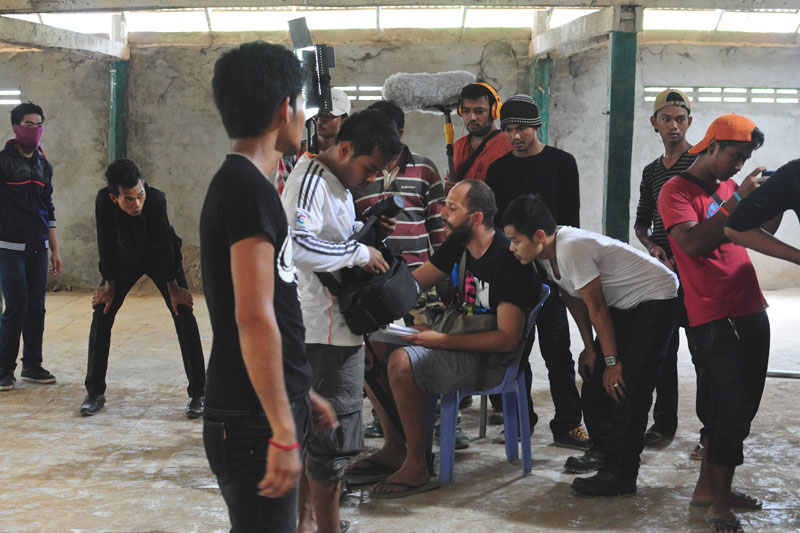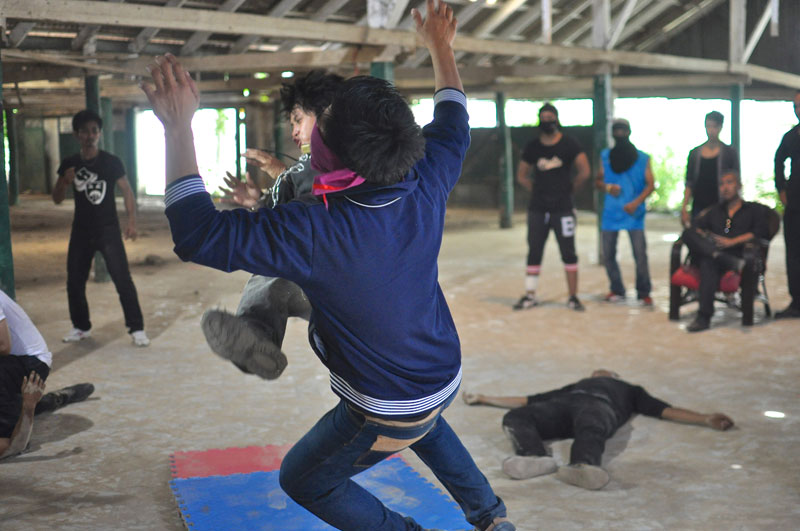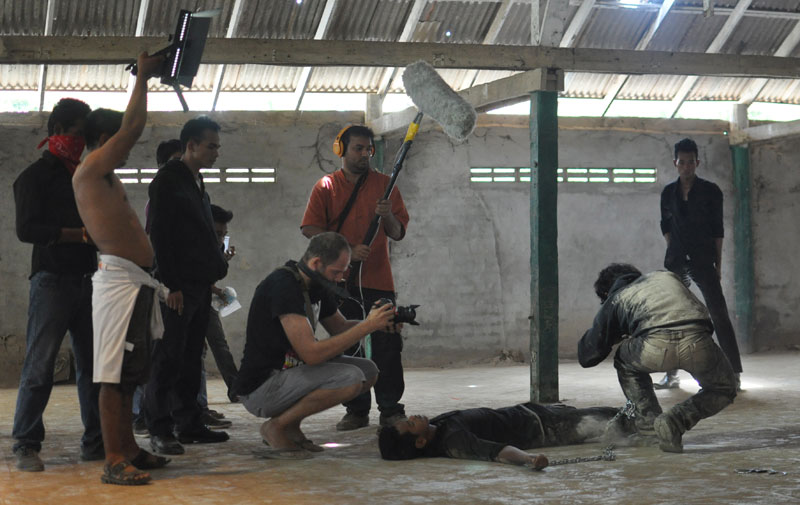In a disused garment factory in Takhmao City, the whizz and whirr of an angle grinder biting through steel rods delays the young martial artists from assembling positions for the filming of a climactic, expertly choreographed fight sequence.
This is one of the drawbacks of filming on a tight budget, according to Italian filmmaker Jimmy Henderson (no relation), who earlier this week finished filming Khmer-language movie “Hanuman: Year of the Monkey.” Another, of course, is that while you shoot, there is nothing to do but suffer the exhausting heat inside the building, and its soggy consequences.

But the advantages far outweigh the drawbacks. Take after take, Mr. Henderson and his camera move and duck amid the acrobatic battle as the young actors—all experts trained in the ancient Cambodian martial art by the Bokator Sor Association—clash and leap and crash to the concrete floor, before being dusted down and cheerfully entering the fray once more.
“Here, there is less bureaucracy and people are more willing to do things that they just wouldn’t do elsewhere—fighting for real, barefoot on hard ground under the blazing sun, for example,” he said.
Mr. Henderson, who also acts as cinematographer and editor and co-wrote the script with Englishman Michael Hodgson, says “Year of the Monkey” will be “a cartoon satire,” and though Cambodians might not quite grasp the sub-genre, there was already a discernible buzz building online even before the tight 17-day filming schedule wrapped up.
The movie follows two brothers, Vicheat and Srong (played by Dara Our and Sophakmith Ung) who as young boys witness their father being murdered by the ruthless gangster Kim Veng (Savin Phillip). The boys are separated—Vicheat is trained in the forest by a master of Bokator, who then sets out on a Batman-style, vigilante revenge mission hidden behind the mask of the Hindu monkey god, Hanuman. His brother Srong, a hard-working and honest police officer, is swept along by his brother’s violent quest and they unite in order to finally vanquish their demon.
It is a standard revenge story, but their journey—in the fashion of Japanese director Takashi Miike or South Korea’s Park Chan-wook—is both incredibly violent and comically slapstick, with a cast of larger than life characters carrying out all sorts of brutality. One of those is “the Doctor,” played by legendary Khmer boxer-turned actor Ei Phouthang, who wholly convinces that he could tear you apart limb from limb—as he does in the film, literally.
Mr. Henderson, who has lived in Cambodia for years and has a family here, previously worked as co-director and cinematographer on the Khmer-language zombie film “Run,” aesthetically elevating that movie to something more than the sum of its regurgitated parts.
“Year of the Monkey,” also funded by Westec Media Ltd., is a different beast. Henderson brings together a 98 percent Cambodian crew, but it is the peculiar brainchild of a Western cinephile in love with his adopted homeland who is hell bent on pushing cinema here forward.
When Rithy Panh’s “The Missing Picture” was nominated for Best Foreign Film award it was an immensely proud moment for Cambodian cinema, yet there is perhaps too much ivory in the auteur’s towering status to have much of a direct influence on populist young filmmakers.
“Year of the Monkey” may not trouble the Oscar committee, but its irreverent blend of uber-violence, risqué humor, convoluted set-pieces and exoticism, all of which evoke Quentin Tarantino, could, Mr. Henderson hopes, help filmmakers transcend the glut of derivative schlock horror to at least a more complex, literate brand of schlock.
“There are not many quality films being made in Cambodia, I think its fair to say. There is no film school here that teaches the history of cinema or develops a sense of understanding about what goes on behind a shot and because of that, most movies are derivative and visually uninventive,” he said.

This is not a criticism of the themes or interests of young Cambodian filmmakers—most movies are re-workings of well-trod stories and themes, but directors differentiate movies by using different tones and styles. In Cambodia, a lack of technical sophistication and illiteracy in the language of cinema makes for repetitive viewing—the idea that “it’s not the story but how you tell it” thus becomes kind of meaningless when everything feels so similar.
“I have a strong visual style and knew exactly what I wanted my movie to look like, but in terms of being both director, cinematographer, writer and trying to manage the set, I have a lot of stuff to do. So I had to show my lighting crew—this is what I want you to do—to remind them that they were not shooting a karaoke movie.
“So I showed them paintings by Caravaggio and Bosch in terms of lighting and composition and they got it, they were like—we know; like the Caravaggio!”
But Henderson is not a purist interested only in refining Cambodian filmmakers’ and filmgoers’ tastes, just as his lack of piety does not preclude a social dimension to his films.
In 2009, for example, he and a collaborator were funded by the British Arts Council to lead “The Strangers Within” film project, which documented the issues facing the minority Romani people in Romania. There are many ways to shed light on such topics and in this case, he travelled through Romania teaching, performing and filming clown-theater in various Romani communities.
“A lot of foreign filmmakers come to Cambodia and focus on the Khmer Rouge era or poverty, and they deal with it in a very serious way and evoke pity, which I believe is very counterproductive for the Khmer people—it casts them as victims instead of empowering them.
“Of course, I don’t wish to deny the thematics of Cambodian society, but I don’t think you need to deal with them in the pious way the press does and film can really explore these issues with greater insight through humor and satire, for example,” he said.
And “Year of the Monkey” covers all the bases—corruption, addiction, murder, brutality, prostitution and gross inequality are all packed in to a high-octane plot with enough sight gags and comedic set pieces to hopefully inure the audience to the film’s more challenging moments, as X-rated antics push the hitherto untroubled boundaries of Khmer good taste.
“Cambodia is a very conservative society which holds back the industry quite a lot, but soon there will be someone who comes and pushes forward and that will lead to a current of people following, which will eventually effect change,” he said.
He points to some “delicate” scenes in the movie that, although relatively mild by Western standards required the trust and bravery of the cast due to the fact that playing such scenes went, culturally-speaking, against the grain.

Savin Phillip, who plays silver-haired gangster and main bad guy Kim Veng, is an entrepreneur and actor who had previously appeared in television dramas and commercials. But he had to give a little more of himself in this role than he was used to.
“Phillip has a number of delicate scenes such as appearing in bed with two women, or singing a romantic karaoke song during a brutal murder scene—these are things he risks being judged by the audience for,” Henderson said. “But he understood exactly what I was trying to do and performed the scenes with the utmost professionalism.”
Similarly, there is a provocative turn from Seng Sona, whom the Cambodian entertainment website Sabay voted sexiest woman of 2013, and should be well-known to the audience. The media celebrity is no stranger to controversy and after her ultra-confident audition the director knew she was the only person for the part of the duplicitous “Lover,” who acts as a catalyst for all sorts of onscreen mayhem.
“It was very unusual in Cambodian to find a girl who could play such a part with so much confidence and she was comfortable pushing the boundaries—so she got the part instantly,” Henderson said.
When he was advised to not have scenes depicting drug uses in the movie, however, he almost despaired. He conceived his arch-villain as a mix of Ben Kingsley from “Sexy Beast,” Gary Oldman from “Leon, the Professional” and Al Pacino from “Scarface,” all of who have defining tics relating to drug-abuse.
Considering the film’s satirical premise and the darkly humorous tone, Mr. Henderson had a “eureka” moment—he gave his villain an addiction to tiger balm, a comical quick that actually becomes quite a subversive image.
There was even a fear that the movie may have been cursed, due to a series of minor mishaps all too likely to befall a film set working in such ad hoc conditions, but the thought lingered that they may be drawing the ire of spirits, too.
The movie may well end up shocking Cambodian filmgoers, Henderson admits. Even if it does, he hopes it will help stimulate the curiosity of the country’s young filmmakers and actors to engage with cinema and become inspired by it—and to continue to challenge audiences’ limited expectations.
“It will definitely shake people, it will feel very different to any other Khmer-made movie. It actually paints a picture of life that most people live and see everyday—how the audience reacts to this is a different matter, they will either love it, or hate it, there will be no in between.”




